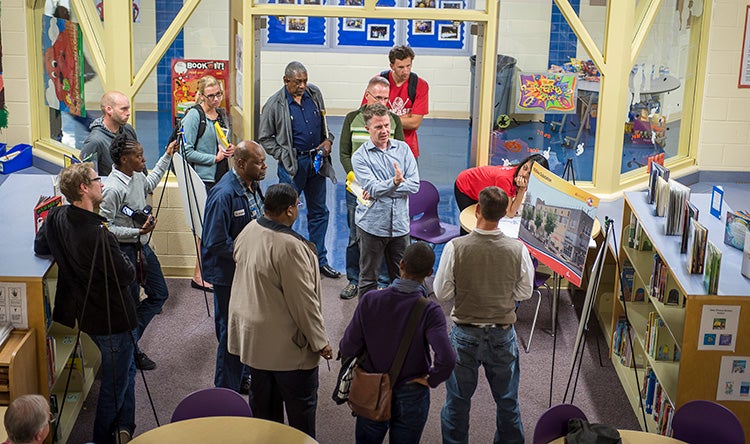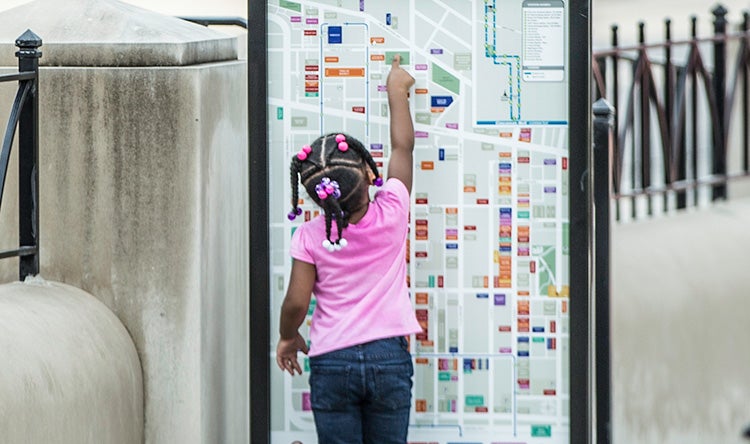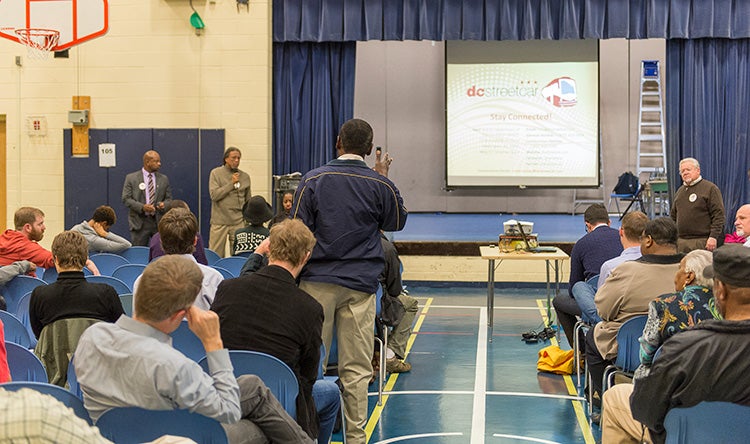
Experts Talk: Environmental Justice and Equity in Transportation With Cathy LaFata
Experts Talk is an interview series with technical leaders from across our transportation program.
How To Build Equity Into Transportation Projects From the Beginning
Large public investments are intended to benefit someone — ideally a wide breadth of beneficiaries. It’s important to make sure all stakeholders are engaged in the planning process so that their diverse interests can inform the project's development. This means seeking out traditionally underrepresented voices, such as low-income or minority communities.
That’s where environmental justice comes in.
The national conversation around diversity and inclusion has important implications for public infrastructure. Public transportation projects play a critical role in providing equity and can determine whether an entire area is accessible to everyone or not. Though there is intense interest in it right now, this concept is not new. A federal executive order requires environmental justice to be considered with any federal action. As part of an environmental justice analysis, public projects owners must consider the potential for disproportionately high and adverse effects on minority and low-income populations. They’re also tasked to solicit input from those people whose voices have been historically absent from public projects.

Today, environmental justice principles provide a way for minority and low-income persons to be an integral part of the planning process. It’s how to ensure transportation projects — often with an intended lifespan of several decades — are providing benefits to the greatest number of people. This process does require some diligence on the part of the project sponsor, but when done right, it can have major benefits to the community.
Cathy LaFata knows how to do this because she has been practicing environmental justice in the transportation world since it was first introduced in 1994, long before the most recent conversations started. LaFata has managed or held key roles in transportation projects across all project development phases and across all modes, with a concentration in transit and rail. She combines diverse technical proficiency with organizational and coordination skills to lead large teams for transportation project delivery success. LaFata sits on the TRB Environmental Justice Standing Committee, APTA Planning, Policy and Program Development Committee and APTA Environmental Justice/Title VI Subcommittee. In June of 2018, she presented at the APTA Rail Conference on the equity issues related to transit-oriented development at rail stations.
Environmental Justice in Transportation
Q. What is environmental justice and how do you achieve it?
A. The textbook definition of environmental justice is the “fair treatment and meaningful involvement of all people, regardless of race, ethnicity, origin or income, with respect to the development, implementation and enforcement of environmental laws, regulations and policies.”
To me, environmental justice is much more than a box that you check during the NEPA process. To achieve meaningful involvement, you must proactively engage with underrepresented communities to thoroughly understand the issues people are facing and really seek to uncover how the project may affect them. Social and environmental justice can only be achieved when we understand what matters to these communities and meaningfully integrate it into the project.
It’s at the core of a project’s framework to make sure that you understand who the project impacts and who the project benefits. By facilitating a two-way dialogue, community members are more likely to feel comfortable expressing their concerns and their needs, and we can create a platform to elevate voices that might have otherwise been ignored.

Q. When should project planners start thinking about environmental justice?
A. From the beginning — long before decisions are made. The entire decision-making process should be framed through an environmental justice or equity lens. Too often, a project gets advanced without this kind of analysis or outreach. Once the project is in motion, it’s almost too late — and environmental justice becomes about mitigating damage rather than finding solutions.
Often a government agency identifies transportation projects based on perceived transportation needs without consideration of how equity can be achieved through a process that embraces inclusion and diversity. It is easy for the voices of underrepresented and underserved communities to go unnoticed. Often residents of these communities do not attend traditional public meetings or write to their city council members about concerns.
To truly incorporate environmental justice, we must reach out directly in creative ways starting early, during the development of the project’s goals, and diligently follow up throughout the process. The entire planning process will then be informed by these voices too, and the project is much more likely to directly improve the lives of those who need it most.
At HDR we recently helped a San Francisco Bay Area county focus its countywide transportation plan on equity. Through a very proactive outreach effort, our team engaged directly with residents in communities of concern to get basic but critically valuable information such as: How do you travel now? What’s important to you? What improvements would you like to see?
Among the things we learned was that these residents were more likely to work at night, when bus routes didn’t run; they wanted better access to frequent and affordable transit; poor pavement was preventing bicycling; and they were concerned for their personal safety. These new insights were able to inform the greater countywide transportation plan and county officials are confident that the projects they advance will benefit the needs of the entire community.

Q. How do you make sure to incorporate as many people’s voices as possible?
A. If you want to be successful, you have to be willing to go to the community — join them at the farmers market, know them from bowling league, community-based church events. Understand their motivators and concerns and be a part of the community. It’s especially important when we’re working in culturally and racially diverse communities who might have different work schedules, a language barrier, distrust of governmental agencies, or any number of other factors that tend to keep them away from attending public meetings.
A few strategies include:
- Have an understanding of the languages spoken in the affected communities and make sure all materials are in prevalent native languages. Agencies should have assigned leads to answer questions in their native language as well, and understand cultural nuances.
- Go to people where they are. For example, pop-up events like swap meets, flea markets and farmer's markets, as well as, community organizations, senior centers, and recreational facilities are all good places to reach people. Staff a table with some information about the project or initiative, and try to include a survey to solicit specific information you need from the community.
- Partner with local community-based organizations. They can share information about the project with the community, and they also can share concerns from the community with us.
In the age of COVID-19, we are doing a lot of this outreach virtually. We host web-based live chats, and for those without internet access, we have conducted telephone town halls.
Q. What about when there are competing interests within a community or when some community members don’t like the process? How do you define success in that case?
A. On any project, not everybody is going to agree. The goal of environmental justice is to elevate those voices that would not have otherwise been heard and include them in the conversation. Having some dissent isn’t necessarily a deal-breaker. In fact, disagreement often gets people thinking — and through creative outreach — hopefully talking.
We learned through two recent telephone town halls for a rail project in the Bay Area that a lot of people from different immigrant communities were angry about the project. The telephone town hall provided them the platform to express their concerns across a variety of topics. The project team got together the next day to discuss the issues and started to address them. We may not be able to address all concerns, but hearing all voices we were able to take early actions that will ultimately make this a better project.
If we can say that we provided opportunities for as many different people as possible to participate in the planning process, and that we tried our best to resolve the issues, that’s a success. This is especially true when you’ve successfully received input from those hardest to reach.

Q. Why spend time and money on environmental justice?
A. Environmental justice analysis is required for federally-funded projects as part of the NEPA process, and doing an insufficient job could mean loss of funding.
But beyond the NEPA process, there are major benefits to communities. Environmental justice provides a voice to those who have historically been underserved, and it focuses on developing projects that do not disproportionately impact those communities nor deny them the benefits of the projects. Strategic engagement and analysis are critical for spending money thoughtfully, wisely, and equitably. An equitable transportation solution benefits the lives of as many people as possible, including those who need it most. These communities will lose trust in civic leadership if their concerns are not incorporated. Advancing a project through an environmental justice lens provides not only a legally defensible environmental review but helps to develop a better project.
In short, it’s the right thing to do.
Inspiration & Advice
Q. How did you become interested in environmental justice?
A. Environmental justice gets at my core of being a fair-minded person. In 1994, at the beginning of my transportation planning career, President Bill Clinton signed an executive order to include environmental justice in NEPA analyses. Like everyone else in the profession at the time, I was trying to figure out what it meant. As I learned more, it spoke to me in such a way that I realized that I had just found my specialty and my passion. And I’ve been working on environmental justice ever since.
Q. What advice do you have for someone just starting to work in the field?
A. There’s no right or perfect way to look at environmental justice. Keep in mind that the keys to success are to know the community affected by the project, to understand the issues, and to be creative in your methodology to adequately analyze potential impacts. Don’t think of environmental justice as just another checklist item to be covered in your NEPA document. Environmental justice encapsulates all of the environmental disciplines to ensure the fair treatment and meaningful involvement of all people throughout the transportation development process. And it is important to realize the planning process can take years so the involvement to address environmental justice issues must be sustained throughout.
To young planners, read a variety of community impact assessments and environmental justice analyses and talk to mentors who’ve done this before. Most importantly, trust your instincts. I have seen brilliantly creative approaches come from early-career planners who really understood the human element. You don’t need decades of experience to really “get it.”
Each Experts Talk interview illuminates a different aspect of transportation infrastructure planning, design and delivery. Check back regularly for new insights from the specialized experts and thought leaders behind our award-winning, full service consulting practice.

